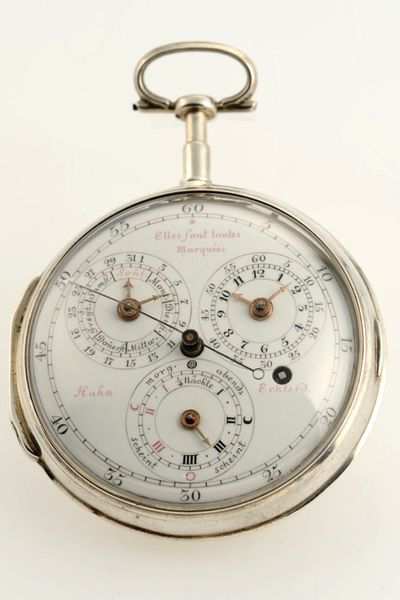Datei:Christoph Matthäus Hahn, Geh. Nr. H 27 circa 1790-1792 (1).jpg

Originaldatei (567 × 850 Pixel, Dateigröße: 92 KB, MIME-Typ: image/jpeg)
Christoph Matthäus Hahn à Echterdingen, Geh. Nr. *H*27, 61 mm, 126 g, circa 1790-1792

|
Alle Bildrechte liegen bei dem Auktionshaus Auktionen Dr. H. Crott. Diese Abbildung ist urheberrechtlich geschützt und steht nicht unter einer freien Lizenz. Für anderweitige Nutzungen außerhalb von Watch-Wiki ist die schriftliche Zustimmung des Urheberrechtsinhabers nötig. |
Museale, bedeutende, deutsche, astronomische Herrentaschenuhr in außergewöhnlich gutem Erhaltungszustand
Geh.: Silber, gestuft, glatt, großes Außenscharnier. Ziffbl.: Email, signiert "Hahn Echterd." und bezeichnet "Elles sont toutes Marquèes" ("Sie sind alle markiert"), äußere schwarze arab. Ziffern mit Angaben für Zentralsekunde und gebläutem Sekundenzeiger; drei Hilfsziffernringe für die Anzeige des Datums und Wochentages bei "10", Stunden- und Minutenangabe mit arab. Zahlen bei "2" und Anzeige der Mondphasen in Kombination mit der Mondscheindauer in Viertelnächten (röm. Ziffern für die Nachtviertel, linke Hälfte rot, rechte Hälfte schwarz) bei "6", vergoldete Zeiger. Werk: Vollplatinenwerk, feuervergoldet, signiert, Unruhanhaltvorrichtung, konische Werkspfeiler, offenes Federhaus, floral durchbrochen gearbeitete und gravierte Unruhbrücke mit Regulierskala, große fünfarmige Messingunruh, Sautroghemmung, facettierter Granatdeckstein auf Unruh.
Eine Aufzeichnung nach dem Tod seines Vaters bestätigt, dass Christoph "eine feine silberne Kalenderuhr" anfertigte. Es ist sehr wohl möglich, dass es sich hierbei um die angebotene Uhr handelt. Somit ist die Uhr auf 1790-1792 zu datieren.
A gentleman's important astronomical German pocket watch of museum quality Case: silver, tiered, polished, large lateral hinge. Dial: enamel, signed "Hahn Echterd." and marked "Elles sont toutes Marquèes" ("they are all marked"), outer black Arabic numerals for the indication of the centre seconds with blued seconds pointer; three subsidiary chapter rings: the date and the weekdays at "10", hours and minutes with Arabic numerals at "2", the moon phases in combination with the time from moonrise to moonset; the last is divided into quarters of the night (red Roman numerals on the left half of the dial, black Roman numerals on the right half) at "6", gilt hands. Movm.: full plate movement, firegilt, signed, seconds stop device, conical movement pillars, open barrel, florally pierced and engraved balance bridge with regulator scale, large five-arm brass balance, horizontal cylinder escapement, facetted garnet endstone on balance.
A note after his father’s death states that Christoph made "a fine silver calendar watch". It is quite possible that this note refers to the watch we have here, which would mean it dates from 1790-1792.
Christoph Matthaeus Hahn (1767-1833) Christoph Matthaeus Hahn, a Court Mechanician in Stuttgart, came from relatively prominent and wealthy family with roots going back to the 16th century. He was the eldest son of the famous Philipp Matthaeus Hahn. Christoph is best known for his calculating machines which he made along with his father, and on his own, after his fathers death. Their calculating machines are considered the predecessors of the modern computers and the name Hahn is found in all the books about the history of computers. Besides making early computers, Christoph (as well as his father) made a few calendar clocks and watches. Only a few are known to exist; one in The British Museum, one in La Chaux-de-Fonds Museum, one was in the former Time Museum in Rockford, USA, and three or four have been on the antiquarian market within the past fifteen years. In 1790 Christoph was nominated as the Court Mechanician in Stuttgart. There are a number of books dedicated to the Hahns, one of the gymnasiums in Echterdingen is named after Hahn, the 225th anniversary of the birth of Philipp Matthaeus Hahn was celebrated with an exhibition in Stuttgart with two-volume catalog, there is an entire museum devoted to the Hahns in Albstadt. The importance and the genius of the Hahns may be best demonstrated by the fact that in 1793, George III of Great Britain, needing a present for the Chinese emperor Chien-lung, chose not a British product but an extraordinary astronomical calendar clock made by the German Hahn.
Dateiversionen
Klicke auf einen Zeitpunkt, um diese Version zu laden.
| Version vom | Vorschaubild | Maße | Benutzer | Kommentar | |
|---|---|---|---|---|---|
| aktuell | 23:05, 16. Okt. 2014 |  | 567 × 850 (92 KB) | Andriessen (Diskussion | Beiträge) | Christoph Matthäus Hahn à Echterdingen, Geh. Nr. *H*27, 61 mm, 126 g, circa 1790-1792 {{Bildrechte U|dem Auktionshaus Auktionen Dr. H. Crott}} Museale, bedeutende, deutsche, astronomische Herrentaschenuhr in außergewöhnlich gutem Erhaltungsz… |
Du kannst diese Datei nicht überschreiben.
Dateiverwendung
Die folgende Seite verwendet diese Datei:
- Bildgalerie Uhrenmodelle Hahn, Christoph Matthäus
- Picture gallery watch models Hahn, Christoph Matthäus
- Galería de imagenes de modelos de relojes Hahn, Christoph Matthäus
- Afbeeldingen galerij uurwerkmodellen Hahn, Christoph Matthäus
- Фотогалерея Модели часов Hahn, Christoph Matthäus
- Galleria fotografica di modelli orologi Hahn, Christoph Matthäus